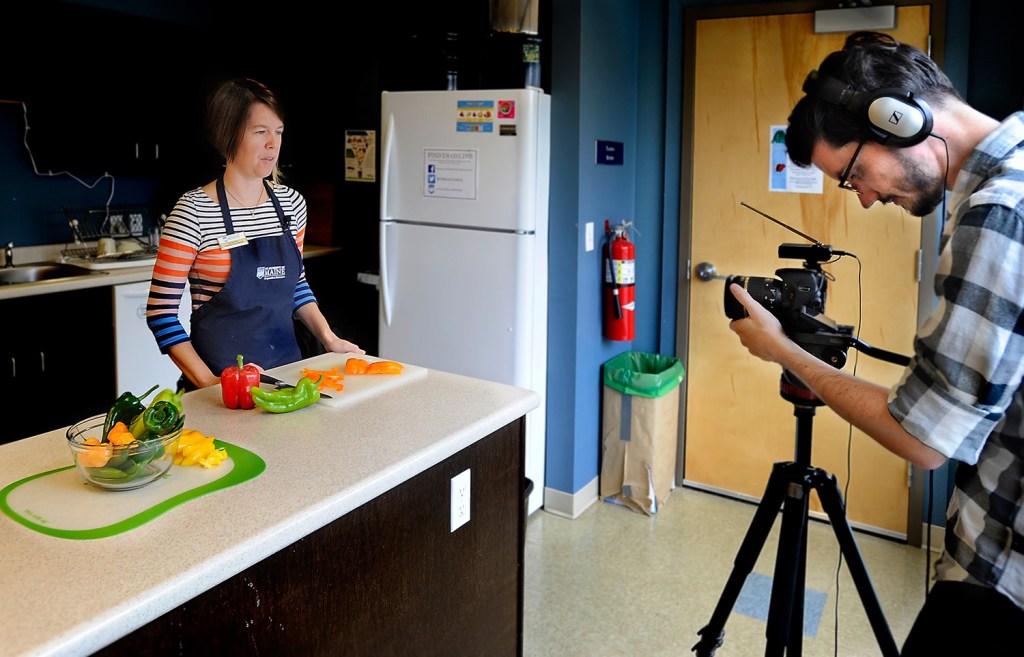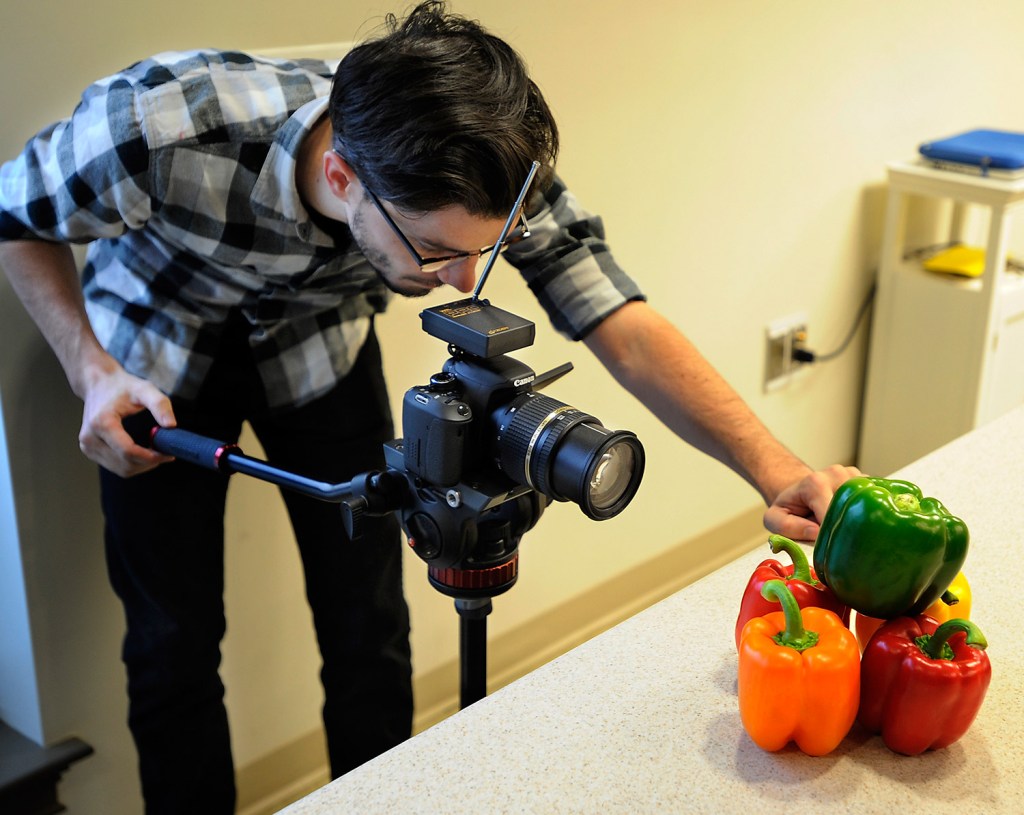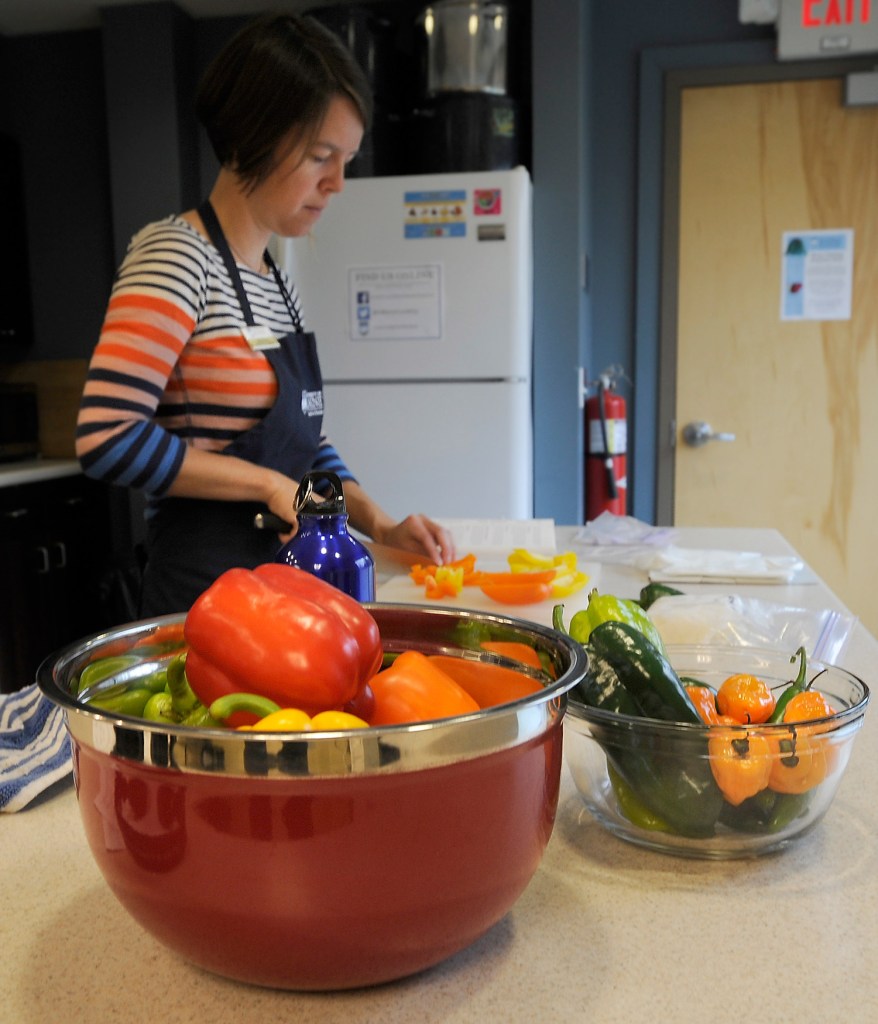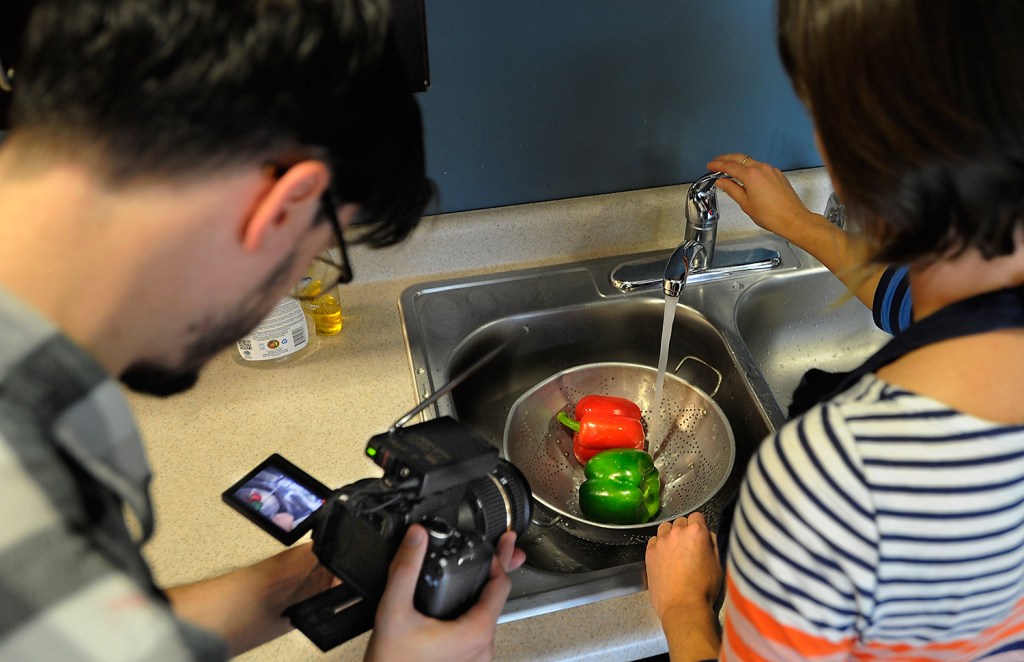FALMOUTH — “Tell me about hot peppers,” Patrick Gill directs Kate McCarty. “Tell the camera about hot peppers.”
It’s movie-making day at the University of Maine Cooperative Extension’s Cumberland County headquarters. The studio, an office park behind Wal-Mart, is distinctly unglamorous, although the natural light illuminating the kitchen set pleases Gill. McCarty, a food preservation assistant, is his star, but it might be a stretch to call her a natural leading lady.
“It’s awkward,” she says of the filming process. “I don’t like it!”
Nonetheless, she endures it, because it’s the end of the 2015 harvest season and sustainability has never been hotter in the modern era. People in Maine and well beyond want to know how to preserve food, prune their trees and put their gardens to bed. Many prefer that their lessons be delivered concisely and via a handheld device.
Founded in 1914, the Cooperative Extension dates back even further to the state land grant universities of 1862 and 1890. The goal has always been to provide a teaching environment for vocational sciences like engineering and of course, agriculture.
But the plan was that Extension would fill in the educational gaps in rural communities. No one expected that a century later the mission might include Extension educators discussing whether they need another “take” or not, or that their pupils might include an urban banker using her time in line for an outrageously expensive hot, caffeinated, pumpkin-flavored beverage to browse her hand-held computer for the best way to prune the raspberry canes this weekend.
Maine’s Cooperative Extension was an early adapter to the trend of making DIY videos and making them available on YouTube. They have been startlingly successful, reaching audiences all over the world. The top 10 most viewed videos alone have been viewed over a million times and all told there are 169 of these videos. McCarty’s lesson on freezing peppers, both hot and mild, will likely be the 170th. She may be a reluctant star, but at least McCarty is comfortable with her director, having worked with him on a few earlier how-to shoots, including videos on drying fruit, herbs and vegetables.
“He has a nice way of saying ‘That wasn’t the most natural delivery,’ ” McCarty said, laughing.
Technically Gill’s title is communication technology professional. He’s based in Extension’s Androscoggin-Sagadahoc counties office, but it is his job to roam the state to add to Extension’s well-traveled library. The topics range from “Starting a Farm Business” to “How to Prevent Sheep Foot Rot.”
The latter has been viewed over 73,000 times, quite possibly because of Extension educator Dick Brzozowski’s co-star, a ewe who gives compellingly plaintive bleats as he trims her hooves with a variety of sharp instruments that look like they belong in a David Cronenberg film.
If you want to kill Japanese beetles, figure out the right recipe for a compost heap, or create a basket weave lattice to grow tomatoes on, Extension has a video for you.
More cost effective than anything they could snail mail or a pamphlet you could pick up at the office, the videos are easier to understand than printed directions and tend to speak directly to our very specific growing zone (or to those around the world who also suffer hard-core winters and late-arriving springs).
“We’re really thinking about it from the eye of the consumer,” said John Rebar, the Extension’s executive director. Consumers want tips and techniques about sustainable living, but they want them fast, “without sitting down for a two-hour movie or going to a lecture,” he said. “So we need to be concise and focused.” About half the viewers of the video channel on YouTube are Maine residents, he said.
GETTING INTO THE BIZ
The push to get videos up on YouTube began, Rebar said, in 2009, when the local movement was rapidly gaining traction.
“We are a constituent-driven organization,” Rebar said. “Our mission is to meet the needs of Maine residents. For me as (executive) director, it was recognizing where our customer is. And they’re on handheld technologies.”
The next step was figuring out what the public wanted. The agrarian society that Extension had been created to serve had shifted in many ways. The home economics knowledge that had long been passed between generations wasn’t nearly as easy to come by as it had been.
“We don’t have the family heritage that we used to,” Rebar said. (Well not him. He grew up mostly on an alpaca farm in Skowhegan and has worked with Extension for three decades.) “Even if your grandmother told you something and it was wrong, at least she told you something.”
He believes Maine’s Cooperative Extension, one of 109 extensions in the nation, was one of the first to get into the movie-making game. Terry Meisenbach, communications and marketing representative for Extension’s national office (entirely virtual) said no record exists of who came first. “I know (Maine’s Extension staff) are very forward-thinking and ahead of the pack,” Meisenbach said. “I certainly wouldn’t doubt it.”
“They are not alone, though,” he added. Extension services around the country are posting online videos with do-it-yourself advice.
Alaska’s Cooperative Extension came out of the YouTube gate at right around the same time Maine’s did (one of its more popular videos is “How to Can Fish in Jars,” with nearly 99,000 views). The University of Vermont’s Extension puts out scads of videos on YouTube, but it must be said, the majority have views only in the double or triple digits; when it comes to YouTube videos, agrarian Maine is beating out agrarian Vermont.
SECRETS TO SUCCESS
As Rebar points out, you can watch YouTube videos on virtually anything. “What sets us apart, what makes it unique to Maine is our seasonality and our Maine Yankee frugality,” he said. “How do we help people save resources and conserve money?”
The videos aren’t meant to be flashy, he said, but the production values have to be high enough so that viewers aren’t distracted from the educational lesson.
“Our videos are not necessarily scripted but they aren’t freelance either,” he said. “They are well planned out, they have all the right props. We’re trying to make a high quality product that engages the customer.”
The videos are branded with Cooperative Extension’s logo, and each starts with the same few bars of an innocuous piece of stock music.
Many were produced before Gill, 28, started working at the Extension in 2012. He’d studied new media at UMaine, but his interest in video goes back to his teen years. He started with a Sony Handicam – “the size of an old Walkman” – and made goofy shorts and action films. Typically he had a camera with him. When he left for college, it was with a treasure he’d saved up for, a Canon GL-2 with manual controls. “It shot in wide screen,” he said, “which was a big deal.”
When he first landed his job with Extension, he tried to make his mark artistically. Like the time he used a handheld camera to shoot Jim Dill, Extension’s bug expert, sitting behind his desk. “I thought I was a hotshot,” Gill said ruefully. After that, Gill relied on the tripod.
Extension’s creepiest video, “How to Look for and Avoid Bed Bugs,” also stars Dill. It was shot cinema verite style in a hotel room by Adam Kuykendall, who is a mentor to Gill. “I pick his brain from time to time about how to be better at my job,” Gill says.
He’s beginning the process of updating some of the videos to give them more uniformity and in some cases, to improve on the script or shooting angles. Not that he’s an auteur about the whole thing, but he’s well aware of the audience, and the potential audience, for the work he’s doing. “The best part is that it’s content that people actually want,” he says. “It’s really validating to see your work actually making a positive impact in other people’s lives.”
And he tries to steer his “actors” with an even hand, always aware that this might be new territory for them. After all, the Cooperative Extension is filled with science types who spend most of their days in labs.
“I don’t think they were necessarily thinking they were going to be on-air personalities when they got their jobs at Extension,” Gill said.
SUPER STAR
Of UMaine’s Cooperative Extension’s YouTube educators, one stands out as the blockbuster star. The Chris Pratt of Extension, as it were. That’s David Handley, who is in five of the top 10 most viewed videos. At press time, the videos featuring him had been viewed over 1.3 million times.
He has had viewers reach out from all over the world, including Canada, South and Central America and many enquiries from Britain. The Maine videos are also popular in Eastern Europe. Someone asked for permission to dub Handley’s voice for Ukrainian viewers – the climate is similar.
Sometimes the places the questions come from surprise him. Like the ones from Washington state or Oregon, both major berry producers. He’s amused by this: “I am like ‘man, you have the University of Oregon-Corvallis right there, why are you talking to this little guy from Maine?’ ”
His popularity may have something to do with the popularity of his subject area, which includes berries. An early hit was “How to Grow Raspberries” from July 2010. Berry growing lessons are huge on the channel; “How to Prune a Blueberry Bush has had over 185,000 views since it came out April 2011. That’s the one where a shaggy-haired Handley tells the viewer, “If this is taking you more than 10 minutes, then you are thinking too hard.”
His biggest hit, with over 265,000 views at press time, is “How Do I Prune Raspberries” from January 2011, which features Handley costumed in head-to-toe denim. Whatever he’s wearing, Handley appears completely at ease in front of the camera.
“I just channel what that raspberry is saying to me,” he said. “And I say, ‘I need to do this or I need to do that or this raspberry is not going to be happy.’ ”
Part of his ease can be attributed to his belief in the medium. “No one calls us and orders fact sheets,” Handley said bluntly. “Even static websites aren’t even cutting it anymore.”
Handley believes that the early popularity of Extension’s videos has something to do with the fact that there wasn’t much else out there with actual experts. “What was out there were from enthusiastic home gardeners and the information was sometimes not … top of the line. Based on experience and not much on science.”
He knows there are rules about the lengths of DIY videos, but he breaks them as needed. “They say over five minutes and you’re dead,” he said. “I discovered pretty quickly that sometimes we need a couple of extra minutes. But we definitely try to keep it under 10.”
And he needs little direction.
“With Dave I have to ask him to slow down because he has it all loaded up in his head,” Gill said.
His second secret is a background in community theater, although at one point he was even less excited to get on the stage than McCarty is to chop peppers on camera. “I went into that backwards, kicking and screaming,” Handley said. He was minding his own business building sets for the community theater in Monmouth, a female-dominated group as so many community theaters are, when he was tapped for “Joseph and the Amazing Technicolor Dreamcoat” in 1994. “Generally if you are an adult male, at some point they are going to throw you into a play,” Handley said, laughing. This fall he’s in a Lewiston production of a lesser known Gilbert and Sullivan musical called “Ruddigore.”
Still, it must be said that Handley, while clearly the human star of UMaine’s Cooperative Extension videos, is not in the most popular video on Extension’s YouTube channel.
That honor falls to the lobsters starring in “Lobster Cooking and Eating,” which had been viewed 441,601 times as Source went to press.
Send questions/comments to the editors.








Comments are no longer available on this story